A View of Kediri City
Kediri is one of Indonesian city, located near the Brantas river. One of a city crossed by the Brantas river from south to the north about 7 kilometers. Kediri has 63,40 km2 width and becomes the third of the biggest city in East Java Province. Kediri city is located in 130 kilometers of southwest of East Java Province capital city, Surabaya, under the slope of Klotok Mountain, near Wilis Mountain.
Kediri city has 3 districts (kecamatan) at west part and east part of The Brantas river. The east part is a lowland plain consists of Kecamatan Kota and Kecamatan Pesantren, the west part belongs to Kecamatan Mojoroto.
According to citizen census on the year of 2012, Kediri city has total citizens of 312.331 persons. Most of the citizens are Moslems, Protestants, Catholics, Hindhuisms, Buddhisms, Konghuchu and other beliefs. Religious condition in Kediri city is full of harmony barely no conflicts among the religious and other beliefs.
One of Kediri city major industries is sugar industry which was established since pre independence era. PG Pesantren Baru is existing and producing as part of PT Perkebunan Nusantara X (PTPN X). Addressed on Mauni street, Kecamatan Pesantren, this sugar factory has production capacity of 6.250 tons per days, number two the biggest sugar factory under the region of PTPN X that includes Sidorajo, Mojokerto, Jombang, Nganjuk, Kediri AND Tulungagung.
In the year of 1930’s, Indonesia was the biggest exporter of sugar after Cuba. At colonial era, sugar became main commodity of colonial. One of sugar production is in Kediri region.
Kediri city also has the oldest sugar factory: PG Meritjan. The factory established since 1809. The production capacity not as much as PG Pesantren Baru about 2.800 tons sugar per days yet PG Meritjan has their own attractiveness for the tourists to visit, the old building with Dutch style.
A Brief History
Archaeological artefacts discovered at the year of 2007 indicated that the region around of Kediri believed as the location of Kediri Kingdom, a Hindhuism Kingdom of the 11th century. The very beginning of Kediri became urban and residence was when Airlangga ordered to move the government center from Kahuripan to Dahanapura. According to Serat Calon Arang (The Letter of Calon Arang), Dahanapura (The Fire City) was known as Daha. After the death of King Airlangga, Medang region divided into two regions: Panjalu in the west part and Jenggala in the east part. Daha became the government center of Panjalu Kingdom and Kahuripan became the goverment center of Jenggala Kingdom. Panjalu also called as Kadiri/Kediri by the lattest writers.
Since Tumapel Kingdom (Singasari) became stronger, the Daha capital city attacked and under control of King Vazal, control of the city passed to Majapahit, Demak and Mataram kingdoms. Kediri taken by Dutch East India Company (VOC) as consequences of Geger Pecinan. East Java Province was controlled by Cakraningrat IV, Adipati Madura who stood in VOC side as he believed the Dutch would help securing the independence of Madura from Kasunanan Kartasura. However when VOC rejected, he rebelled. The rebellion surpressed by the VOC, who got assisted from Pakubuwana II, Sunan Kartasura. Kediri became under control of VOC and remained under Dutch controls until The Indonesian Independence War.
Tourism Sector
Kediri city and around has potential tourism objects that could developed as local potentials. Government of Kediri city is building and developing tourism sectors for more job opportunities, increasing incomes, local actual earning and national actual earning as well. For supporting the tourism development, government of Kediri city give guidance to the residences about discipline and clean living awareness, add or upgrade public facilities, improve the public services for local and foreigners, reconstructions, tourism objects development and promotion through the local electronic media and foreign.
The efforts also to encourage private companies for taking part of tourism section development with availabilities of hotels and acommodation, supporting facilities that serve comfort for visitors. Many natural tourism objects that has potential such as Selomangleng cave, Wilis mountain, Brantas river and attractions such as Airlangga museum, Kadiri Kingdom heritage sites.
Natural Tourism:
- Selomangleng Cave
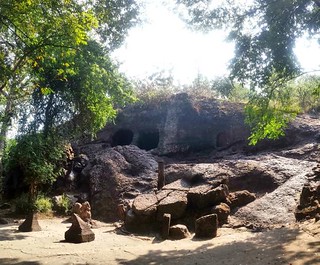
Located on the slope of Klotok mountain, Pojok village, Kecamatan Mojoroto, the cave believed constructed at 10-11 BC. Known from the folklore, Selomangleng cave as Dewi Kilisuci’s (Sanggramawijaya Tunggadewi) hermitage, the crown princess of Airlangga King from Kahuripan kingdom.
2. Jiput Wellspring
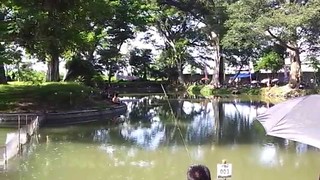
Jiput wellspring located in Rejomulyo village, Kecamatan Pesantren that sacrified by people around. Jiput wellspring believed as centered of water and wind. The wind spiritually appeared then bursted into whirlwind. To stop the whirlwind, the wellspring should be closed with jiput (broom stick). Besides the spiritual story behind, Jiput wellspring used to support local farming, drinking water and daily needs.
3. Cakarwesi Wellspring
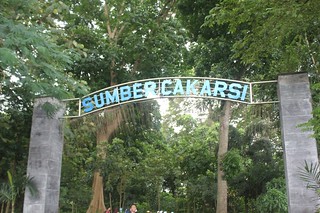
Cakarwesi wellspring located in Tosaren village, Kecamatan Pesantren. At Kediri kingdom era, the wellspring is a secret gate to Kediri that used by Raden Wijaya while attacking the celebration of Tartar soldiers which was celebrating the winning of war and succeeded killed Prabu Jayakatwang. Cakarwesi today is a green open space with high trees. Fresh atmosphere around became its own attractiveness.
4. Dadapan wellspring

Dadapan wellspring located in Dukuh Dadapan, Tinalan village, Kecamatan Pesantren. Dadapan wellspring believed has a related history with the story of Panji “Ande-ande Lumut”. Long time ago in the village, lived a widow known as Mbok Rondo Dadapan who has 3 beautiful daughters, Kleting Abang, Kleting Hijau and Kleting Kuning. Ande-ande Lumut was pseudonym of Panji Asmara Bangun. In the folklore of Ande-ande Lumut, Mbok Rondo Dadapan expected one of her daughters became wife of Ande-ande Lumut. However, Kleting Kuning (stepdaughter) the one who choosed to be his wife. Kleting Kuning is pseudonym of Dewi Sekartaji/Dewi Candra Kirana.
Cultural/Spiritual Tourism
- Airlangga Museum
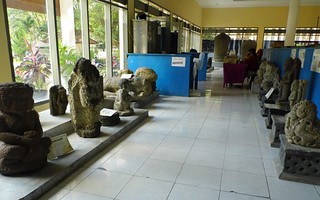
Airlangga museum is Kediri city government museum that accomodate 147 archaeological and ethnographic collections. The museum established since November 30th 1991, located in Mastrip street number 1, near Klotok mountain and Selomangleng cave. The museum conserved archaeological collections from the glorious era of Kediri kingdom to Majapahit kingdom.
2. Masjid Agung
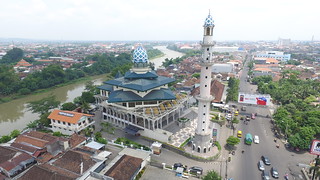
Masjid Agung located in front of Kediri city square with width about 1388,8 m2. According to the first Prasasti Kayu Jati which was written on the crown of the old joglo mosque crafted on the year of 1771 BC, believed that Masjid Agung Kediri built for the first time in the year of 1771 BC. The second Prasasti Kayu Jati written on the mimbar of the mosque said: Kolo Adegipun Minbar Mesjid Ageng Ing Kediri Sabtu Pahing, Wulan Haji Kaping 5, Tahun Alif 1261 Min Hijrotin Nabiyyi Min Makkata Ilal Madinah. The prasasti told about the building date of mimbar in the year of 1261 Hijriyah or 1841 BC.
3. Syeh Wasil Tomb
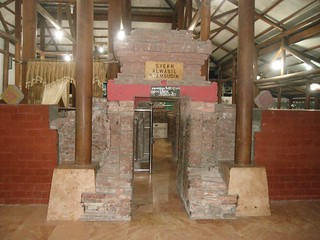
Before the growth of Islam in Kediri, Setono Gedong was a worshipping place for certain believers. This proved by the existing of statue sites that discovered around Setono Gedong. After the growth of Islam in Kediri, Setono Gedong area that formerly has many worshipping statues, replaced, became worshipping place for Islam, marked with the Setono Gedong itself and the tomb of Islam figures, Syeh Wasil Samsudin (920-929 Hijriyah or 1514-1523 BC)
4. Oldman Boncolono Tomb
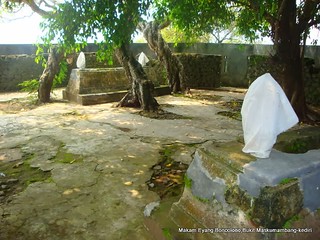
Oldman Boncolono Tomb located in the Area of Selomangleng Tourism, on top of Maskumambang hill. Oldman Boncolono is a generous figure who has divine power to stole colonial goods and shared with poor people. He also called as Maling Gentiri (Gentiri the Thief)
5. The Red Church (Immanuel Church)
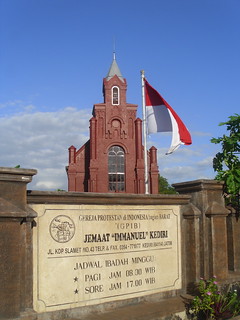
The history of Immanuel Church Kediri has been known from prasasti on the left wall of the church’s gate, made from marble with written words: “De Eerste Steen Gelegddoor Ds.J.A.Broers 21 Dec 1904 J.V.D Dungen Gronovius Feci”. At the Dutch era the church called as “Keerkeraad Van De Prolestanche Gemente Te Kediri”. The church has neo gothic architecture style with slim and high impression.
6. Tjoe Hwie Kiong Temple
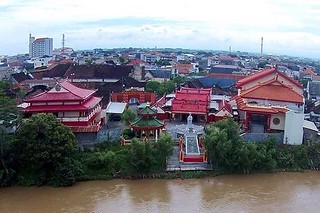
Tjoe Hwie Kiong Temple is a Tri Dharma temple located in Yos Sudarso street number 148, Kediri, East Java. Named as Tri Dharma (the third dharma) because of the place is a worshipping place for Taoism, Buddhism and Confucianism. There is Tri Nabi altar as name of the three altars inside the building, Lao Tzu statue for Taoism with Yin Yang symbol, Budha Sakyamuni statue for Budhism with Swastika symbol and Confucianism Prophet statue for Confucianism with Genta symbol.
Main Products of Kediri City
Kediri city empowered small industries by supporting and funding the works to improve products and attract more customers. The products such as:
- Kerajinan Tenun Ikat Bandar Kidul (Woven Craft of Bandar Kidul)
- Kerajinan Anyaman Bambu (Bamboo Wicker Art)
- Kerajinan Kaca Hias (Grafir) (Artglass)
- Nasi Pecel Jalan Dhoho (Pecel Dhoho Street Culinary)
- Industri Tahu Kuning (Yellow Tofu Industries)
- Industri Getuk Pisang (Banana Cake Industries)
Kediri City Culinary
Kediri city culinary has friendly and minimalist taste, ease to find and made as well, such as pecel tumpang, soto ayam and tofu.
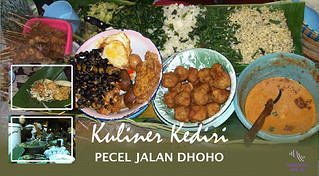
- Pecel Tumpang (fresh vegetables with peanut sauce, largerly found at Dhoho street)
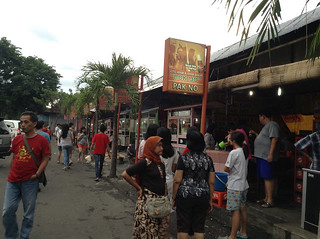
2. Soto Ayam Bok Ijo (chicken soto, largerly found at Bok Ijo area)
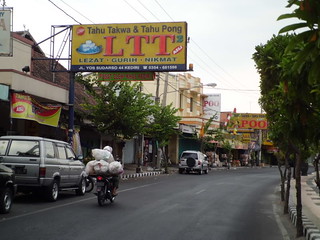
3. Pusat Oleh Oleh Jalan Yos Sudarso (local food and snack shopping center at Yos Sudarso street)
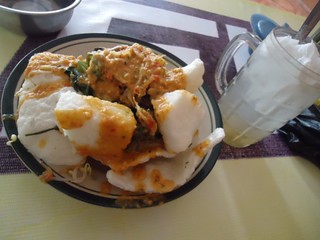
4. Pecel Punten (varian of pecel with punten as substitute of rice)
- Accommodation
- Grand Surya Hotel Kediri (Jl. Doho No. 95, Kediri City)
- Hotel Merdeka Kediri (Jl. Basuki Rahmat No. 4, Kediri City)
- Insumo Palace Hotel & Resort (Jl. Urip Sumoharjo No. 90, Kediri City)
- Lotus Garden Hotel (Jl. Jaksa Agung Soeprapto No. 26, Kediri City)
- Viva Hotel (Jl. Letjen S. Parman no 86, Kediri City)
- Citihub Hotel Kediri (Jl. Joyoboyo 21, Kediri City)
Cultural Sector
The bond of nature and historical formed cultural values. Local people as subjects take part as sustainer of the cultural values. Looking back from the glorious era of Kediri kingdom, Kediri today has many art and cultural diversity. 127 art groups exist to sustain the cultural values, dancing, jaranan, reog, jemblung, campursari, ketoprak, wayang and dangdut orchestra. Kediri government fully support the artworkers to improve cultural art diversity. Many programs, coaching and strategies did to create good quality of artworks.
Potential Sanggar in Kediri City
Sanggar Panoleh located in Pandean village, Kecamatan Kota lead by Hary Pratondo. Many art performances performed for local and national events such as Jaranan dance, Seribu Barong dance, Seribu Jaran Kepang, Jaranan Tekno, Jaranan Mudo. Sanggar Panoleh also honored to perform for Kediri city at Anjungan TMII Jakarta.
Sanggar Budaya Nusantara lead by Susilo Wasktoko established at October 21st 2008 in Pojok village Kediri city. Most of the dancers are student of SMKN 2 Kediri (vocational school) that often perform for local and national events. Honored awards for Songgolangit Patemboyo dance, Garudo Muko dance, Bledug Kelud dance, Gregah dance and Gemrantang Jati dance.
Dwija Laras lead by M. Tohir. The dancers are students of SMPN 6 Kota Kediri (junior high scool). The performances are including dances and karawitan.
Sanggar Seni Langit lead by Agus Budianto established at August 16th 2010 located in Burengan village with warfare colossal dance as main performances for Kediri city big events.
Guntur Dance Company established at July 2nd 1986 located in Mojoroto village, Kecamatan Mojoroto. Lead by Ety Kusumaningtyas with 10 coreographers, 112 dancers and gamelan drummers, Guntur Dance Company honored many awards from local festival and national festival.
Performed at Anjungan Jawa Timur TMII Jakarta, Karya Tari East Java Province, Night Spekta HUT Prov. Jatim, APEKSI, Semipro Probolinggo, Kediri Nite Carnival, Arang and many more. The signature artworks are Tari Kethek Ogleng (performed in Southeast Asian countries), Wedariningtyas dance, Songgolangit Patemboyo dance, Kidung Tresno Keduwung dance, Topeng Panji dance, Panji Semirang dance, Sendratari Yuyu Kangkang, Sendratari Calon Arang, Jotosuro Murko and many more.
Guntur Dance Company as one of medium to develop local cultural art and support the government to sustain traditional values, improve the quality of local art as national assets. At 2015, Guntur Dance Company honored to represent Kediri city to perform at Asia Africa Conference in Bandung, West Java Province. For the achievements, Guntur Dance Company honored to perform in Melbourne Fringe Festival, Australia.
Performances of SENDRATARI Guntur Dance Company on Melbourne Fringe Festival 2017 in Australia:
“Kethek Ogleng”
A part of Kediri Kingdom history, the story began when a woman was walking bravery through the underbrushes. Setumpi met a white animal in the form of white monkey who could speaks (Toto Jalmo). Apparently the white monkey was a loyal servant of Joyo Kapindanu from Bantar Angin Kingdom who sent by a King who named Klono Siwandono for proposing Dewi Sekartaji.
Looked at the beauty of Roro Setumpi, Joyo Kapindanu carelessly forgot about his duty, Joyo Kapindanu falled in love and aimed to propose Setumpi to be his wife. This called as “Kethek Ogleng”. If Setumpi rejected, she will be killed. Setumpi thought for long time and will be agree with conditions. Setumpi distracted Joyo Kapindanu then he soundly asleep. This was a good chance for Roro Setumpi to escape and continue her journey to look for her husband named Panji Asmorobangun.
“Kidung Tresno Keduwung Dance”
Kidung Tresno Keduwung dance is a part of the history of Kediri Kingdom, an expression of Putri Lodoyo heartbreak after her asked to marry Prabu Joyoboyo got rejected. She met Prabu Joyoboyo again and told him once again what she was aiming for yet Prabu Sri Aji Joyoboyo refuse the princess then the war between two of them happened. The princess surpressed, Prabu Joyoboyo called the princess has mythical gigantic character so the princess turned into a gigantic statue.
“Topeng Panji Dance”
Illustrating a prince figure with good mind and manner, patience and strong character. A covered of Panji as common people to look for his wife also to see his self the condition of Jenggala Kingdom’s people with his undercover mask. Jenggala Kingdom’s people barely known if he was the son of the king. Topeng Panji dance danced with beautiful knight’s character movement as well as Panji Asmoro Bangun figure of the part of Jenggala Kingdom Kediri History.
“Songgolangit Patemboyo”
At a time of Kediri Kingdom era long time ago, there was a beautiful princess named Putri Songgolangit. Many kings came to Kediri to ask her for a marriage. She wondered and anxious about the choices therefore she held a Patembaya (demands) for whom who has:
- Hovered carriage.
- Fascinating magical stone never existed in the world.
- The groom companions must walk through underground with musical marches.
Many many kings challenged the patembaya then caused war. Pujonggo Anom was the one who harmonized the war with legendary whip, pecut Samandiman.


